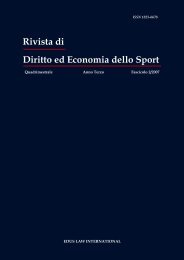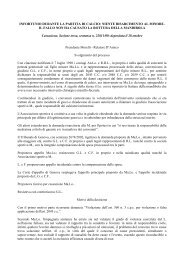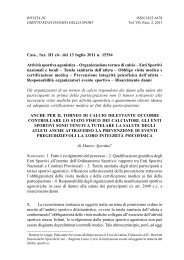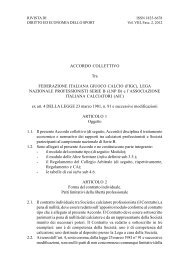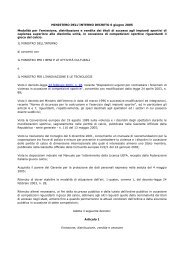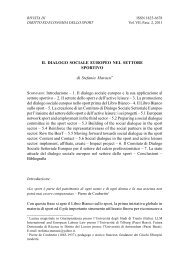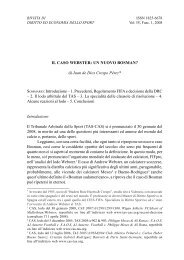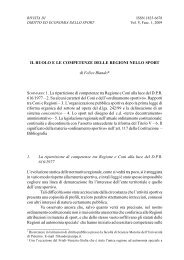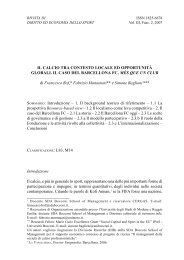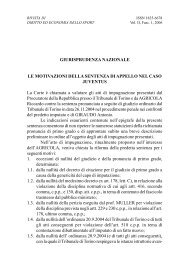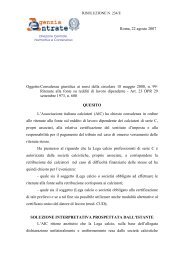European Sports Law and Policy Bulletin THE BERNARD ... - Slpc.eu
European Sports Law and Policy Bulletin THE BERNARD ... - Slpc.eu
European Sports Law and Policy Bulletin THE BERNARD ... - Slpc.eu
You also want an ePaper? Increase the reach of your titles
YUMPU automatically turns print PDFs into web optimized ePapers that Google loves.
124 Rob SimonsVery interesting in this regard is also the Meca Medina judgment of the<strong>European</strong> Court of Justice from 2006. In its decision, the Court of Justice made animportant legal point by rejecting the theory of the existence of «purely sportingrules», falling a priori outside the TFEU (<strong>and</strong> therefore its articles 101 <strong>and</strong> 102 10 )<strong>and</strong> affirming to the contrary that each sporting rule should be studied case bycase in the light of the provisions of articles 101 <strong>and</strong> 102 TFEU. 11So the question whether <strong>European</strong> law applies to sports activities can beanswered affirmative. However, already in 2001 an agreement was reachedbetween FIFA <strong>and</strong> the <strong>European</strong> Commission where it was said that «it is nowaccepted that EU <strong>and</strong> national law applies to football, <strong>and</strong> it is also now understoodthat EU law is able to take into account the specificity of sport (...)». 12 Provisionsin the FIFA Regulations like contract stability, transfer windows, trainingcompensation <strong>and</strong> regulations concerning minors, which in principle infringe<strong>European</strong> law, were allowed as being «specific».In conclusion, to some extent sports federations have their own autonomyto set up rules within the «specificity of sports». Before the Meca Medina judgment,these rules were not subject to EC law since they were for «purely sporting interest».However, as determined in Meca Medina by the <strong>European</strong> Court of justice; «ifthe sporting activity in question falls within the scope of the Treaty, the conditionsfor engaging in it are then subject to all the obligations which result from thevarious provisions of the Treaty. It follows that the rules which govern that activitymust satisfy the requirements of those provisions, which, in particular, seek toensure freedom of movement for workers, freedom of establishment, freedom toprovide services, or competition». 133. Freedom of movement <strong>and</strong> the protection of minorsIn the Bernard case it was decided that even though the concept of trainingcompensation forms a violation of article 45 TFEU, the infringement is justified bythe objective of encouraging the recruitment <strong>and</strong> training of young players. This isnot the first time the Court has assessed sports regulations to the freedom ofmovement provisions. The most famous example in this regard is the 1995 Bosmancase where the transfer system at the time, which required a club to pay a transferfee for a player whose contract with another club had expired, was declaredincompatible with the EU freedom of movement of workers.When it comes to minors <strong>and</strong> the freedom of movement of workers,important to emphasize is that in order to be able to rely on this right the youngster__________________10At the time of the Meca Medina judgment, the competition law provisions were laid down inArticles 81 <strong>and</strong> 82 EC. In the TFEU, these articles were renumbered to Articles 101 <strong>and</strong> 102 TFEU.11Wathelet Report, Sport governance <strong>and</strong> EU legal order: present <strong>and</strong> future 2007, 25.12Press Releases RAPID, Commission closes investigations into FIFA regulations on internationalfootball transfers, Brussels, 5 june 2002.13Case C519/04 P, David Meca-Medina <strong>and</strong> Igor Majcen v. Commission, ECR 2006 I-6991, atpara. 28.



